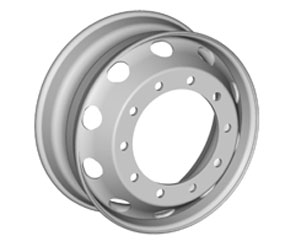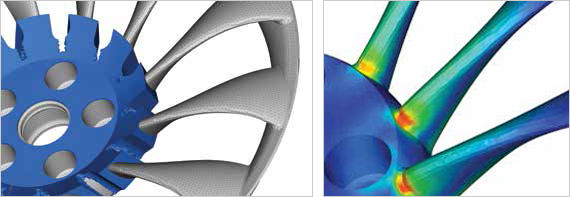The company helps its worldwide customers deliver lower weight, safer and more fuel-efficient vehicles thanks, in part, to its product development process.
Beginning in 2005, the company tested, and then adopted, a simulation-driven design process with optimization as the first step in the development cycle. Following optimization, engineers introduced into the process finite-element analysis (FEA) for performance verification as well as fatigue life analysis, testing and data acquisition. This emphasis on simulation technology coupled with a simultaneous engineering approach has enabled Maxion to shave months off product development time and weight off its wheels — while meeting all test requirements.
A Proof-of-Concept Project
Carlos E. Lopes was responsible for Maxion Wheels’ Commercial Vehicles (CV) Steel Wheels Engineering group in 2005. At the time, the company’s team of engineers was seeking a new path for innovations in wheel design.
Altair Brazil was engaged in conversations with Maxion regarding its goals and offered training as well as direct project assistance, along with introductory HyperWorks® software licensing. Lopes explains that the Altair team led engineers through a proof-of-concept project applying optimization technology. With the professional skepticism of the experienced technical staff on full alert, Maxion set a weight reduction target of 1.5 kg for a steel wheel, knowing full well that the maximum weight that could be removed to pass testing requirements was 0.3 kg.
Lopes says, “Our attitude was one of ‘why not?’ We felt that perhaps the mathematics of Altair’s OptiStruct® software might do something interesting, even though there was no reason to believe it would give results relevant to the real design requirements of steel wheels for heavy trucks.” The outcome of this endeavor was spectacular. It led to development of a product that broke all test performance records known at that time, with a low weight and high predictive accuracy of final test results that were never before conceived as possible.
The initial success with OptiStruct aligned perfectly with the Maxion Wheels brand promise of providing highly customized products to different markets at the lowest possible weight with safe and technologically- robust designs. With the combination of optimization and other simulation tools, the company reduced the development time expectations from six months to reach 0.3 kg of weight reduction to 45 days for a 1.5 kg reduction while meeting all test requirements.
 Maxion Wheels produces steel wheels for commercial vehicles (shown) and light vehicles as well as aluminum wheels. The company has adopted a simulation-driven design process with optimization as the first step.
Maxion Wheels produces steel wheels for commercial vehicles (shown) and light vehicles as well as aluminum wheels. The company has adopted a simulation-driven design process with optimization as the first step.
Opportunities in the Millions
From 2005 till now, the optimization process has evolved and has been deployed to every single family of Maxion Wheels products and uncountable new single components, generating competitiveness for the brand, patents, safety for the products and savings beyond $20 million.
One example of this high competitiveness was reached in 2007, when the Maxion CV engineering team was challenged to design a wheel that out-performed a major competitor while avoiding intellectual property related to the competitor’s design.
“In a demonstration of how impactful optimization technology can be to a business,” explains Lopes, “we designed a unique wheel that met all performance targets while saving weight and costs. As a result, a new product was successfully launched, avoiding patent infringement, and our business in that sector was able to export to a new region, from a recently started new facility in China.”
Another significant business opportunity arose in 2012, when the company was challenged to beat the toughest competitor in Europe after it had set a new market standard for a 9 x 22.5-in. tubeless steel wheel for a heavy truck, fully tested via Biaxial (ZWARP test) methods.
Maxion assembled a global CV engineering team and benchmarked the best components and materials within the company. By combining the benchmarked best-in-category bill of materials with an intensive OptiStruct design effort for the disc, a new wheel made its debut.
The result was that within two months, the team achieved a 0.6 kg savings over the competitor’s new target, including full product design, tooling design, manufacturing and 30 days of physical testing. What’s more, six months later, the company notched an additional 0.7 kg of savings.
Today, the industry benchmark for the lightest 9 x 22.5-in. tubeless steel wheel for commercial vehicles is in the range of 33 kg, thanks to further development led by Maxion Wheels’ team in Germany.
Rolling with the Challenges
Maxion Wheels’ products vary by region and customer. Its CV Wheels operations in South America, for example, produce 2.2 million wheels per year, targeting one of the most challenging product performance markets in the world. Brazil has 213,000 km of paved roads and 1.3 million km of unpaved roads. With greater than a 6:1 ratio of unpaved versus paved roads — and a pervasive practice of overloading trucks on the uncontrolled highway infrastructure — Brazil represents a vast and difficult testbed for a manufacturer of wheels.
Other regions present unique challenges of their own. For instance, certain areas of China and India are known to regularly overload to 50% over the allowable truck limit, exacerbating the wheel wear caused by poor road conditions. In contrast, the United States, with its 4.3 million km of paved roads, represents a dream market for achieving maximum efficiency with lightweight designs to reduce fuel consumption.
Targeting sales to every OEM in the world requires Maxion to continuously search for innovations which will allow customized products for specific markets while achieving the lowest weight and highest safety for each application. The inherent characteristics of steel and aluminum wheels provide an excellent platform from which to help achieve lowered carbon dioxide emission goals through the positive impact that high-performing and lightweight products can offer.
Lopes remarks, “All of the above was feasible due to the Maxion Wheels CV engineering team members, who proved to be great, synergic professionals. Different departments focused on a common goal, compiling data from optimization, FEA, data acquisition, manufacturing, testing and market performance. The success came from their strong willingness to collaborate and compete.”
 OptiStruct from the Altair HyperWorks suite enables Maxion Wheel’s engineers to perform topology optimization (top) in addition to structural analysis (bottom).
OptiStruct from the Altair HyperWorks suite enables Maxion Wheel’s engineers to perform topology optimization (top) in addition to structural analysis (bottom).
Based on Maxion’s track record of success, optimization has become institutionalized as the first step in its simulation-driven product development cycle at CV engineering. Lopes says, “We credit Boeing with coining the phrase, ‘Have you OptiStructed this part?’ and turning optimization into a sine qua non condition for moving forward with the design development of a new part. The pressure for continuous weight reduction is constant in all markets. There are carbon dioxide low-emission programs all over the world — Euro VI in Europe, EPA 10 in the United States, Proconve 7 in Brazil and National 5 in China — and we need to continue pushing for weight reductions to increase fuel efficiency.”
Lopes, who is now Global Advanced Engineering Director for Maxion Wheels, explains that one of his main roles is fostering the use of simulation and leading-edge technology across multiple applications throughout the enterprise. For example, in addition to its continued use of optimization, customer requirements for new design features have pushed the company toward other innovative approaches, including the use of design software from solidThinking®, a wholly owned subsidiary of Altair.
“With Altair’s support and the process flow throughout its software modules,” says Lopes, “we have implemented simulation of key design and manufacturing steps such as flow form, casting and thermal expansion among movable parts. With simulation-driven design, we are creating a deep understanding of our products and manufacturing processes. This deeper understanding inevitably leads to lighter, higher quality, safer and simply better products for Maxion’s customers
Simulation also plays a critical role in the passenger car aluminum wheel market, where styling is a crucial differentiation. Lopes notes combining performance, low weight and differentiated styling is only possible by using simulation in concert with aesthetic development.
“An upper-market brand recently posed a unique styling request,” says Lopes, “and via an innovative surfacing approach coupled with OptiStruct, we were able to develop a brandappropriate styling interpretation of a complex topology optimization.”
A Global Force

Maxion Wheels is a division of Iochpe-Maxion, whose other businesses include Maxion Structural Components and AmstedMaxion. Maxion Wheels operates 23 manufacturing plants in 12 countries, producing more than 60 million wheels per year.
- It produces steel wheels for light vehicles in Brazil, Mexico, the USA, Czech Republic, Germany, Spain, Turkey and India.
- Aluminum wheels for light vehicles are produced in Brazil, Mexico, Czech Republic, Italy, Turkey, Thailand and South Africa.
- Steel wheels for commercial vehicles are made in Brazil, Mexico, the USA, Germany, Turkey, India and China.
- The company sells 40% of its products in Europe, 28% in Brazil, 24% in North America and 8% in Asia.
Full-Speed Ahead
Lopes anticipates that Maxion’s product development process will rely more heavily on simulation technology in the coming years. The number of project updates and the OEMs’ demands to shorten product development time are already pushing the envelope of the virtual development and validation process.
Maxion Wheels is proud of its innovative approach to product development — and the value it delivers to customers. Lopes says, “By using a simulation-driven design process and standing on our track record of having achieved significant product weight savings and quality improvements via optimization, Maxion’s customers perceive the value added to our products.
“Combining our diligence in passing global safety test requirements with the ability to customize products for regional markets and brand-differentiated products,” he adds, “has positioned us as a team player to be counted on by our customers to help them win — on whatever regional and market sector playing field they are competing.”
To learn about OptiStruct and how optimization can benefit your designs, visit www.altair/maxion.
Beverly A. Beckert is Editorial Director of Concept To Reality.